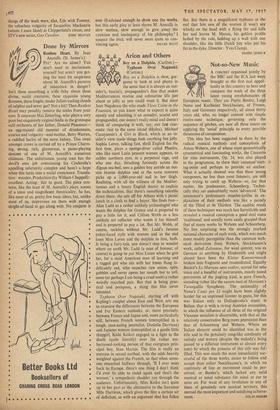Not-so-New Music
A CONCERT organised jointly by the BBC and the ICA last week brought us the first real oppor- tunity in this country to hear and compare the work of the three latest young revolutionaries of European music. They are Pierre Boulez, Luigi Nono and ICarlheinz Stockhausen, of France, Italy and Germany respectively, all about thirty years old, who, no longer content with simple twelve-note technique, governing only the sequence of pitches, are now all three intent on applying the 'serial' principle to every possible dimension of composition.
This idea has been suggested to them by the radical musical methods and conceptions of Anton Webern, one of whose most geometrica* symmetrical and fascinating works, the Concerto for nine instruments, Op. 24, was also played in the programme, to show their common*start- ing-point and perhaps to provide an anchor. What it actually showed was that these young composers, no less than most listeners, are still only trying to catch up Webern—or, for that matter, his predecessor, Schoenberg. Techni- cally they are undoubtedly more `advanced.' The announcer's preliminary murnbo-junibo in ex- planation of their methods was like a parody of the Third at its Thirdest. The audible result of these techniques was much less formidable and revealed a musical conception a good deal more `traditional' and aurally more easily grasped than that of many works by Webern and Schoenberg. No less surprising was the strongly marked national character of each work, which was much more readily perceptible than the common tech- nical derivation from Webern. Stockhausen's work, called Zeitmasse, for wind quintet, was as German as anything by Hindemith and might almost have been the Kleine Kammermusik broken into fragment and reconstituted. Equally Boulez's Le Marteau sans maitre, scored for solo voice and a handful of instruments, mostly tuned percussion of the jingling kind, is pure French, sounding rather like the square root of Messiaen's Turangalila Symphony. The nationality of Nono's Cant! per 13 might have been slightly harder for an unprimed listener to guess, for this was Italian only as Dallapiccola's music is Italian, that is with a strong Austrian intonation, in which the influence of all three of the original Viennese serialists is discernible, with that of the relatively conservative Berg more prominent than that of Schoenberg and Webern. Where an Italian element could be identified was in the title and in the genuinely song-like continuity of melody and texture (despite the melody's being passed to a different instrument at almost every. note) by which the promise of this title was ful- filled. This was much the most immediately suc- cessful of the three works, easier to follow and accept than either Stockhausen's, in which no continuity of line or movement could be per- ceived, or Boulez's, which lacked any solid musical or tonal substance for mind or ear to seize on. For want of any revelation in any of them of genuinely new musical territory, this seemed the most important and satisfying achieve-


































 Previous page
Previous page